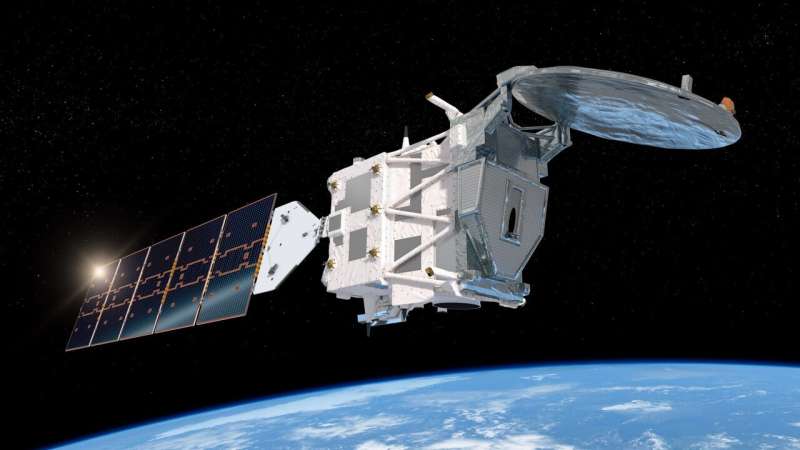This article has been reviewed according to Science X's editorial process and policies. Editors have highlighted the following attributes while ensuring the content's credibility:
fact-checked
trusted source
proofread
EarthCARE on cloud nine after smooth start to mission

ESA's EarthCARE mission has completed its important "Launch and Early Orbit Phase" and is ready to begin the commissioning of its four scientific instruments. The data they gather will improve our understanding of the role that clouds and aerosols play in Earth's radiation balance and benefit both climate modeling and weather forecasting.
EarthCARE launched at 00:20 CEST on 29 May on a SpaceX Falcon 9 rocket from Vandenberg Space Force Base in California, U.S.. A launch is always spectacular—decades of hard work have led to this pivotal moment—but it doesn't last long. Just 10 minutes after launch, EarthCARE separated from the rocket and was, for the first time, alone in orbit.
EarthCARE then began switching on key systems and deploying its long, trailing solar array—or, at least, that's what the Flight Control Team at ESA's ESOC mission control center in Germany hoped. This sequence of activities was carried out automatically and mission control had to wait for the first signals from the satellite to confirm that everything had gone as planned.
Approximately 52 minutes after launch, as EarthCARE passed over Hartebeesthoek satellite station in South Africa, they received this all-important 'acquisition of signal' from the new mission. The ESA team could now lock on to the spacecraft and begin receiving telemetry data containing information on its status following the mechanical stress of launch.
"It's always tense in the moments before we capture the first signal. Until then, we are not yet in control," explains Isabel Rojo, EarthCARE Spacecraft Operations Manager.
"The moment that the first telemetry arrives is cause for celebration, but it also sparks a flurry of activity inside the Main Control Room. EarthCARE is now in our hands, and we immediately begin assessing the spacecraft's health and preparing it for life in orbit."
With the confirmation that the spacecraft had successfully executed its first commands and that the solar array had deployed correctly and was generating power, EarthCARE Flight Director, Jose Morales, declared: "we have a mission!"
EarthCARE is the most complex of ESA's Earth Explorer research missions—missions that deliver critical information to fill critical gaps in our scientific knowledge of our planet, and subsequently help address environmental challenges. With the climate crisis upon us, EarthCARE's mammoth task is to shed new light on the complex interplay between clouds, aerosols and radiation within Earth's atmosphere to improve our understanding of how the atmosphere drives the climate system.
But first, there were some important steps to take following its placement in orbit.
Over the next few days, a period known as the "Launch and Early Orbit Phase," the EarthCARE team switched on and assessed the functionality of the satellite's other core systems. ESA's Flight Dynamics team calculated the precise orbit that EarthCARE had been inserted into by its launcher, while ESA's Space Debris Office regularly scanned this orbit to ensure it was free of any risk of collision with another spacecraft or piece of debris.
This phase also saw the deployment of EarthCARE's reflector, part of the Cloud Profiling Radar instrument provided by the Japanese space agency, JAXA.
"The main challenge that we faced during this phase of the mission was to remain fully focused during long night shifts, which were packed with important operations that could afford no mistakes. We are happy to report that everything went very smoothly, and all operations were completed according to plan," says Isabel Rojo.
Now that the LEOP is complete, the extended EarthCARE Mission Control Team has begun to disperse, with many of the extra specialists and engineers allocated months ago at the start of the launch campaign now being reassigned to new missions and duties.
What remains is the Flight Control Team, which will oversee EarthCARE's journey to its operational sun-synchronous orbit at an altitude of 393 km and assume responsibility for the mission's six-month commissioning phase. This phase comes with its own challenges, as EarthCARE's four instruments are complex, and the scientific goals of the mission depend on them being calibrated extremely accurately. The Flight Control Team will then continue to oversee the mission as it enters routine operations next year.
"EarthCARE's critical first days in space were trouble-free thanks to the excellent preparations made by teams across the ground segment and the good performance of the satellite so far," explains Jose Morales.
"We are excited to welcome this important mission to the family of spacecraft flown from ESOC. It is testament to the hard work and expertise of our teams that we continue to be trusted to operate challenging missions on the frontier of human knowledge. It is these missions that help us better understand our planet and enable us to take informed action to protect the life that calls it home."
Provided by European Space Agency





















